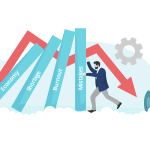What does turnover have to do with business liability?
September 1, 2022

The job market has been in constant flux over the last few years. In the early stages of the pandemic, employers across industries were forced to cut pay and trim staff. Then came the Great Resignation: employees, triggered by broader reflections on work-life balance, quit in droves, with companies scrambling to backfill roles. Now, with economic uncertainty and rising inflation, employers have, once again, been battening the hatches.

However, the changes many have made to weather the storm—tightening budgets, layoffs, particularly in the tech sector, and doing more with less overall—come with major organizational risks. And if you don’t have the right team by your side, you won’t have the resources or skill you need to grow your business and manage professional exposures. From there, productivity, performance, and morale plummet and the potential of a lawsuit skyrockets.
Keep reading to learn more about why talent retention is a critical part of your organization’s risk management strategy—and how you can improve your churn rate.
RELATED: Why are employers losing the talent war?
Disclaimer: Please note the information provided herein offers guidelines only and is presented from a liability-based perspective to help you avoid insurance claims. It is not exhaustive and should not take the place of legal advice. For specialized guidance, please consult a lawyer or a licensed insurance representative.
How does retention affect your business liability?
Staff departures are a huge drain on company resources, particularly in knowledge-based industries that rely on specialized skillsets and qualifications. In addition to the upfront costs of hiring and replacing someone, even one resignation could affect key business metrics for quite some time.
1. Brain Drain
When a top performer leaves, you’re not just losing an employee; you’re losing valuable organizational knowledge, development strategies, and even key relationships that’ll hamper your team’s ability to execute. It’ll take time for junior employees and new hires to rebuild that intel and become even half as efficient, especially if you don’t have the time, energy, or experienced personnel to properly train them or the infrastructure to promote. Getting staff up to speed might even be more difficult given the challenges of onboarding and skills transfer in a remote environment.
RELATED: Employment Practices Liability Insurance: What is it, What’s Covered, and What’s Not?
2. Client Experience
Depending on your industry, client needs may be relatively unaffected by economic slowdown. But if you’re too short staffed to support demand, your business—and your reputation—could suffer. What if your remaining employees don’t have the experience needed to address complex problems? Or if they’re too overloaded to handle multiple accounts with the same level of care? After a few months of poor service and missed deadlines, even your most loyal clients might not have the patience to stick around. And these days, bad reviews travel like wildfire; you might have trouble finding new clients if word spreads that you’re difficult to work with or hard to reach.
RELATED: Professional Liability Insurance: What is it, What’s Covered, and What’s Not?
3. Morale
Team disruptions are catastrophic for productivity and effectiveness. Employees that are already tired, unmotivated, or stressed out could quickly become burned out from extra responsibilities and time pressures. Supervisors, low-level managers, and senior executives are put under tremendous strain from supporting staff or putting in extra hours to catch-up on their own work instead of focusing on innovation or corporate objectives.
Over time, unfair treatment, heavy workloads, and a toxic work environment could cause more employees to leave, spiking turnover. Alternatively, employees could become hostile, leading to harmful allegations of mismanagement, negligent hiring, unfair treatment, discrimination, harassment, and more against your company.
RELATED: Work, Sleep, Eat, Repeat: Managing the Burnout Crisis
4. Mistakes
Employees that are disengaged or exhausted tend to be less aware of their surroundings, which could raise the number of safety incidents, jobsite injuries, and equipment breakdowns. In fact, 75% of leaders in 2021 agreed that their people were making more mistakes or faltering on projects as a result of burnout. Additionally, with no direct oversight, employees that are working remotely might try to maintain efficiencies by cutting corners or being lax on data security, resulting in more errors and privacy breaches. Even a small slip-up or accident could lead to a lawsuit against your business for negligence or third-party injury and property damage.
RELATED: The 8 Most Frequently Asked Questions About Professional Liability Insurance
5. Insurance Costs
We know insurance isn’t exactly your number one priority when it comes to employee engagement. But here’s a little known secret: depending on the type of coverage you need, insurance companies may look at your turnover rates to get a sense of your company’s risk profile. How many employees left voluntarily? How many were fired?
A rate of higher than 20-25% is a huge red flag for most insurers. That means high turnover won’t just increase your chances of being sued, it’ll also lower your chances of being able to adequately protect your organization and recover following a lawsuit.
Why Retention Matters—Even in a Recession
Talent management is rarely top-of-mind when times are tough. Businesses that are focused on staying afloat simply don’t have the resources to attract or retain top talent, while others may not see retention as a priority if they believe employees are unlikely to quit during a recession.
But employee needs should never be on the back burner. We know, it’s tempting to keep the status quo, or cut staff, but try not to overcorrect. It’s only a matter of time before things rebound and despite our current market conditions, knowledge-based industries are still facing a growing skills shortage, an aging workforce, and widespread burnout—challenges that will persist long after a potential recession may end. Even if employees aren’t taking the plunge just yet, workers that don’t feel valued or appreciated could be easily poached by a competitor. Or they might be planning an exit strategy for later.
While you can always backfill roles, talent attraction is only one half of the equation. It’s not enough to just get people through the door; you’ve got to find the right talent, you’ve got to get them to stay, and above all, you’ve got to make sure they don’t destroy the culture you’ve worked so hard to build. Even one bad hire could set your budget, productivity, and morale back substantially and increase turnover.
That’s where retention comes in. It’s much easier to retain quality employees than hire and train new ones. And if you’re not putting in the effort now, you’ll be facing talent shortages—and all the business risks that come with them—down the line. By concentrating on retention, you can proactively plug holes, stabilize your business, and focus on execution, instead of tackling vacancies as they arise.
RELATED: How much will a bad hire really cost your business?
What can employers do?
Talent retention impacts every aspect of your company’s performance—and that makes it a fundamental cornerstone of risk management. In order to combat turnover and improve business outcomes, all organizations need a dedicated strategy that attracts new talent and retains quality staff, regardless of what’s happening in the market.
But retention is about more than a fun workplace and decent pay. It’s about putting people at the centre of business growth instead of treating them like commodities. It’s about a total rewards package that prioritizes working conditions, learning opportunities, and wellness plans that support workers in all aspects of their lives. It’s about creating a positive, healthy culture in which employees thrive and feel fulfilled.
Focusing on the employee experience and delivering on total well-being is one of the best ways to ensure business success. After all, human capital is your single greatest asset and unless you treat it with the same level of care and investment that you pour into other assets, you’ll be sacrificing long-term sustainability for short-term wins.
How can we help you?
For more comprehensive guidance about your organization and your wellness planning, connect with PROLINK. As a licensed broker with over 40 years of experience, we can help you make sense of the shifts in the labour market and what they mean for your business, regardless of your company’s size, trade, or workforce. Our dedicated advisors will help you:
- Identify and assess your risks so you can make informed decisions about talent retention;
- Align your organization with specialized risk management, insurance, and group benefits solutions that will improve the employee experience and reduce your exposures; and
- Continuously monitor your plans so they evolve to meet your needs long-term while keeping costs predictable.
Connect with PROLINK today to learn more!
PROLINK’s blog posts are general in nature. They do not take into account your personal objectives or financial situation and are not a substitute for professional advice. The specific terms of your policy will always apply. We bear no responsibility for the accuracy, legality, or timeliness of any external content.




